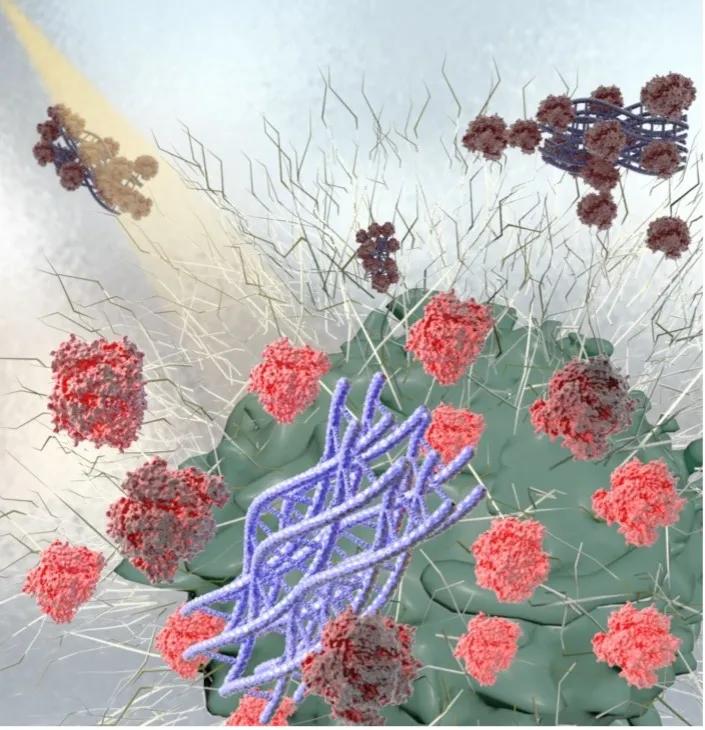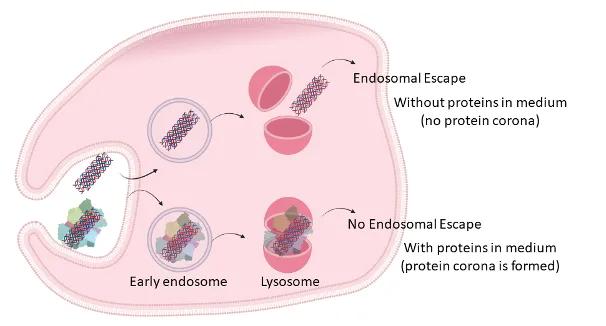Targeted drug delivery is a topic of interest to scientists around the world. A new contribution to this area has now been made by researchers from the Laboratory of Biophysics led by Oleg Lunov from the Division of Optics. The group was exploring biological properties and the efficiency of cellular delivery using DNA nanostructures (DN).
They created an artificial DNA structure to carry a target substance into a cell, exploring how this process is effected by the protein corona. Unlike the DN production method, which is well known to researchers, nobody so far has looked at how the protein corona effects DN behaviour inside cells. The results of the study have been published by ACS Applied Materials and Interfaces.
In cooperation with scientists from the laboratory led by prof. Nicholas Stephanopoulos from the US Arizona State University, who prepared the DN for the Czech team, the researchers from the Institute of Physics have demonstrated that a DN following its exposure to biological liquids ends up encapsulated by the so called protein corona. This however has an adverse effect on the process as it reduces a DN ability to escape from an endosome, and to transport its content further into a cell or into the body.
“To be able to succeed in biomedical applications, it is key for us to understand the interactions between a DN and the living cells. In spite of the on-going, intensive research, the interactions between modified DNA nanostructures and the living cells have still not been well defined. But their application is wide-ranging, and they can be used in a number of biomedical disciplines. Our research aims to explore them in more detail, and to describe their mechanisms at a molecular level, said Dr. Oleg Lunov.
The study has confirmed that a DN ability to escape an endosome can be improved by covering the DN with a peptide aurein 1.2 layer. It is an important improvement helping tackle the endosomal escape as the key challenge in the research of cellular targeted delivery.
The results of the research have shown, among other things, that the whole process still needs to be optimized for us to be able to use the improvement for targeted delivery (for e.g. targeted delivery of drugs). This challenge is subject to further studies.
A detailed imaging of the living cells was enabled by a new IXplore SpinSR10 Olympus ultrafast super resolution imagining system, which is owned by the Institute of Physics. Using this system, researchers have found that the efficiency with which a cell absorbs a DN differs significantly across various cell lines, and even across phenotypically related cells, and is size-dependent.
“Our study serves as a basis for optimizing the DN as a targeted delivery system for different biomedical applications,“ said Dr. Alexandr Dejneka, the Head of the Optics Division and the Department of Optical and Biophysical Systems.
Structural DNA nanotechnology is a new direction of nanoparticle research and of its medical application. This technology enables creating oligonucleotide nanostructures that have a strictly controlled size, shape and surface functionality, making them a highly sought-after solution in biomedical applications (for example in biological sensing, imagining, drug administration and cell engineering).
Literature:
Barbora Smolková, Tara MacCulloch, Tyler F Rockwood, Minghui Liu, Skylar J W Henry, Adam Frtús, Mariia Uzhytchak, Mariia Lunova, Martin Hof, Piotr Jurkiewicz, Alexandr Dejneka, Nicholas Stephanopoulos, Oleg Lunov. Protein Corona Inhibits Endosomal Escape of Functionalized DNA Nanostructures in Living Cells. ACS Appl Mater Interfaces. 2021

